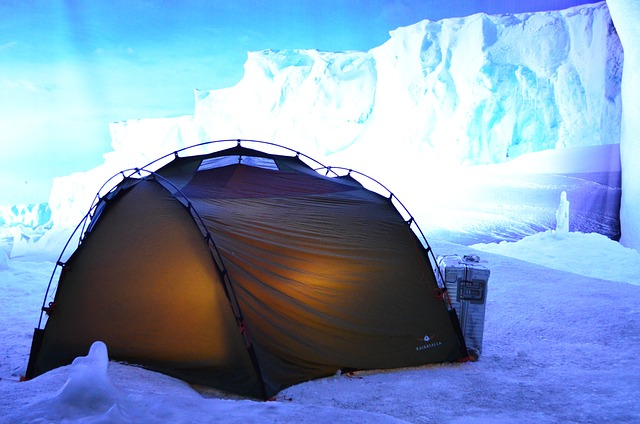Are you ready to take on the exhilarating challenge of winter camping? If so, I’ve got some valuable tips to share with you on how to insulate your tent for winter camping and those chilly adventures. When it comes to winter camping, proper insulation can make all the difference in keeping you warm, cozy, and ready to enjoy the beauty of the snowy outdoors. So, grab a cup of hot cocoa, sit back, and let’s dive into the world of tent insulation for winter camping!
Understanding the Importance of Insulation
Picture this: you’re all bundled up in your cozy sleeping bag, surrounded by the serene winter landscape. Outside, the wind howls, and the temperatures plummet, but inside your tent, it’s like a warm oasis. How is this possible? The answer lies in the importance of insulation.
Insulation is the key to keeping warm in cold weather conditions. When you’re camping in winter, the temperature difference between the inside of your tent and the frigid air outside can be extreme. Without proper insulation, that biting cold can quickly seep into your tent, turning your camping experience into a shivering nightmare.
But fear not, my camping friend! With the right insulation, you can create a barrier that traps your body heat inside, shielding you from the icy grip of winter. It’s like wrapping your tent in a warm, snuggly blanket.
Not only does insulation keep you comfortable, but it also has some important safety implications. When you’re exposed to prolonged cold temperatures, your body can lose heat rapidly, leading to hypothermia. Proper insulation helps regulate the temperature inside your tent, reducing the risk of this potentially dangerous condition.
So, whether you’re an experienced winter camper or embarking on your first snowy adventure, don’t underestimate the power of insulation. It’s the secret ingredient that turns a freezing campsite into a cozy retreat. Get ready to enjoy winter camping like never before!
Choosing the Right Tent for Winter Camping
When it comes to winter camping, choosing the right tent is absolutely crucial. It’s like picking a sturdy shelter that will protect you from the elements and provide a warm haven amidst the wintry landscape. Here are 7 key factors to consider when selecting a tent for your winter escapades:
- Four-Season Capability: Look for a tent specifically designed for four-season or winter camping. These tents are built to withstand harsh weather conditions, including strong winds, heavy snowfall, and low temperatures. They typically have stronger frames, durable fabrics, and reinforced poles to handle the extra demands of winter camping.
- Sturdy Construction: A robust tent is a must when camping in winter. Opt for a tent with a solid construction that can withstand the weight of snow buildup and resist gusts of wind. Check for reinforced seams, sturdy zippers, and a reliable rainfly to provide additional protection.
- Inner Mesh and Ventilation: While insulation is essential for warmth, proper ventilation is equally important. Look for a tent that has adjustable vents or mesh panels to allow for airflow and reduce condensation. This will help regulate moisture levels inside the tent and prevent excess moisture from dampening your gear or causing discomfort.
- Size and Space: Consider the size of the tent and ensure it provides enough space for both you and your gear. Remember that winter camping often requires bulkier clothing and additional equipment, so having extra room to move around and store your belongings is beneficial. Look for tents with vestibules or gear lofts to keep your gear organized and protected from the elements.
- Ease of Setup Tent: When it’s cold and windy outside, the last thing you want is to struggle with a complicated tent setup. Look for a tent that is relatively easy to pitch, with color-coded or intuitive pole systems. Practice setting it up before your trip to become familiar with the process and save yourself some frustration in the field.
- Weight and Packability: Winter camping gear tends to be heavier due to the need for sturdier materials. However, consider the weight and packability of the tent, especially if you plan on backpacking or hiking to your campsite. Balance the need for durability with the practicality of carrying the tent comfortably.
- Reviews and Recommendations: Don’t forget to read reviews and seek recommendations from experienced winter campers. Their insights and firsthand experiences can provide valuable information about the performance and durability of different tent models in cold weather conditions.
Remember, your tent is your home away from home during winter camping. So, take your time to choose a reliable, weather-resistant, and spacious tent that will be your cozy sanctuary amidst the winter wonderland.
Insulating the Tent Walls
Now that you have the perfect tent for your winter camping adventures, let’s focus on insulating those tent walls to create a warm and snug haven. Here’s a step-by-step guide on how to insulate your tent walls effectively.
1. Choose Insulation Materials
There are several options for insulating tent walls, each with its own benefits. Foam panels, thermal blankets, and mylar sheets are popular choices. Foam panels provide excellent insulation but can be bulkier to pack. Thermal blankets are lightweight and reflect heat effectively. Mylar sheets are another great option as they provide insulation and can be easily cut to fit your tent’s dimensions. Consider the pros and cons of each material and choose the one that suits your needs best.
2. Measure and Cut Insulation
Once you have selected your insulation material, measure the dimensions of your tent walls. Use these measurements to cut the insulation material into panels that will cover the entire surface of each wall. Ensure a snug fit without leaving any gaps that could allow cold air to seep in.
3. Attach Insulation to Tent Walls
Start by attaching the insulation panels to the inside of your tent walls. Depending on the material you’re using, you can use tape, adhesive, or clips to secure the insulation in place. Take care not to damage the tent fabric while attaching the insulation. Ensure that the insulation is properly adhered to and covers the entire wall surface.
4. Consider Reflective Surfaces
If you’re using mylar sheets or thermal blankets, make sure the reflective side faces inward towards the tent’s interior. This will maximize the insulation’s ability to reflect and retain heat, keeping you cozy inside the tent.
5. Seal Seams and Gaps
Insulation is most effective when there are no gaps or air leaks. Take the time to seal any seams or gaps in your tent walls using duct tape or the seam sealer. This will prevent cold drafts from entering and heat from escaping.
6. Test and Adjust
Before heading out on your winter camping trip, spend some time inside the insulated tent to gauge its effectiveness. Pay attention to any areas that may still feel drafty or cold. Make adjustments as needed, such as adding extra insulation or sealing any remaining gaps.
Remember, the goal is to create a thermal barrier between the inside of your tent and the cold outside.
Insulating the Tent Floor
OK. Now that you’ve tackled insulating the tent walls, let’s not forget about the often-overlooked but equally important task of insulating the tent floor. Cold ground seepage can quickly sap away your body heat, so let’s ensure you have a warm and comfortable base. Here’s how to insulate your tent floor for optimal winter camping:
- Choose Insulation Materials: There are various options for insulating the tent floor. Foam mats, thermal blankets, and insulated sleeping pads are popular choices. Foam mats provide a layer of insulation and cushioning. Thermal blankets reflect heat back toward your body. Insulated sleeping pads offer both comfort and insulation. Consider your comfort preferences, insulation needs, and packability when selecting the right material for you.
- Lay a Groundsheet or Tarp: Before setting up your insulation, lay a groundsheet or tarp on the tent floor. This additional layer will act as a barrier against moisture and help protect your insulation from the cold ground. Make sure the groundsheet or tarp is cut to fit the dimensions of your tent’s floor.
- Place Insulation Material: Once the groundsheet is in place, lay down your chosen insulation material evenly across the tent floor. Ensure that the insulation covers the entire surface area, providing a consistent layer of warmth. If you’re using foam mats, you can interlock them to create a seamless insulating surface.
- Overlap and Secure Insulation: If you’re using multiple pieces of insulation, overlap the edges to eliminate any gaps. Use tape or adhesive to secure the insulation together and prevent shifting while you’re inside the tent. This will maintain an even layer of insulation and keep you cozy throughout the night.
- Position Sleeping Gear: After the insulation is securely in place, set up your sleeping bag and any additional bedding on top of it. This will provide an extra layer of insulation between you and the cold ground. Opt for a well-insulated sleeping bag suitable for cold temperatures, and consider using an insulated sleeping pad for added comfort and warmth.
- Test and Adjust: Before embarking on your winter camping adventure, spend some time inside the tent to ensure the insulation is working effectively. Lie down on your sleeping gear and assess if any cold spots or drafts are present. Adjust the insulation or add additional layers if needed, ensuring a snug and well-insulated floor.
Insulating the Tent Roof and Ceiling
To create a truly warm and well-insulated sanctuary, you can’t forget about the tent roof and ceiling. This area is often overlooked, but insulating it properly will help trap heat inside your tent and keep you cozy during those frosty nights. Here’s how to insulate your tent roof and ceiling effectively:
- Reflective Coatings: One option for insulating the tent roof and ceiling is to apply a reflective coating. These coatings are designed to reflect heat back into the tent, helping to maintain warmth. Look for products specifically formulated for tent use. Follow the manufacturer’s instructions to apply the coating evenly on the interior surface of the tent roof.
- Thermal Liners: Another effective method is using thermal liners designed for tent insulation. These liners often have reflective surfaces and insulation properties, helping to prevent heat loss through the tent ceiling. Install the liner by attaching it to the inside of the tent roof, ensuring a snug fit. Use clips, adhesives, or other appropriate methods to secure it in place without damaging the tent fabric.
- Attach Insulation Material: If you don’t have access to reflective coatings or thermal liners, you can use insulation material to create a warm barrier. Cut insulation panels to fit the size and shape of your tent’s roof and ceiling. Attach them using tape, adhesive, or clips, making sure to cover the entire area. Foam panels or thermal blankets are suitable choices for this purpose.
- Seal Seams and Gaps: Just like with the tent walls, it’s important to seal any seams and gaps in the roof and ceiling to prevent drafts and heat loss. Use duct tape or seam sealer to ensure a tight seal and minimize cold air infiltration. Pay close attention to areas where the roof and walls meet, as these are common spots for heat to escape.
- Test and Adjust: Before heading out on your winter camping trip, spend some time inside the tent to assess the effectiveness of the insulation. Pay attention to any areas where cold air may still be penetrating or where heat is escaping. Make adjustments as needed, such as adding extra insulation or reinforcing seams, to ensure maximum warmth and comfort.
Additional Tips for Insulating Your Camping Tent
Absolutely! Here are 8 additional tips and tricks to enhance the insulation of your camping tent for those chilly winter adventures:
- Sealing Seams and Gaps: In addition to sealing the seams and gaps in the tent walls, roof, and ceiling, pay attention to other areas where cold air might sneak in. Check the tent’s doors, windows, and any vents or openings. Use weatherstripping or draft stoppers to seal these areas and prevent heat loss.
- Utilize a Rainfly: A rainfly not only protects your tent from moisture but also adds an extra layer of insulation. When properly secured, it creates an air gap between the rainfly and the tent, acting as an additional barrier against the cold. Make sure the rainfly is taut and covers the entire tent for optimal insulation.
- Add an Inner Tent: If you have the option, consider using an inner tent or tent liner. These are designed to fit inside your existing tent and provide an extra layer of insulation. They can help trap heat and create a warmer environment within the tent. Look for models with thermal properties specifically designed for winter camping.
- Use Heat Reflective Blankets: Heat-reflective blankets or emergency blankets can be incredibly useful for enhancing insulation. Place them strategically on the tent walls, floor, and ceiling, reflecting your body heat back toward you. These lightweight and compact blankets are an affordable addition to your insulation arsenal.
- Minimize Tent Openings: While it’s important to have proper ventilation, limiting the number of openings in your tent can help retain heat. Keep doors and windows closed as much as possible, especially during the coldest times of the day or night. Use vents strategically to balance airflow and heat retention.
- Choose the Right Sleeping Gear: Your sleeping bag and sleeping pad play a significant role in insulation. Opt for a winter-rated sleeping bag that provides ample warmth for low temperatures. Consider using an insulated sleeping pad with a high R-value to provide additional insulation from the cold ground.
- Dress Appropriately: Insulating your tent is essential, but don’t forget to dress warmly as well. Layer up with thermal clothing, moisture-wicking base layers, and insulating outerwear. Wearing a hat, gloves, and warm socks will help retain body heat while you sleep.
- Stay Hydrated and Nourished: Staying hydrated and well-nourished helps regulate your body temperature. Make sure to drink plenty of fluids and eat high-energy, warm meals to keep your body fueled and generate heat.
Embrace the beauty of winter while staying warm and comfortable inside your insulated tent.
Conclusion:
Congratulations, fellow winter campers! You’ve now armed yourself with a wealth of knowledge on how to insulate your tent for camping and those exhilarating winter adventures. With the right insulation techniques, you can transform your tent into a warm and cozy haven amidst the snowy landscape.
By understanding the importance of insulation, you recognize its ability to keep you comfortable and safe in cold weather conditions. Remember, insulation acts as your shield against the biting cold, allowing you to enjoy the beauty of winter without sacrificing warmth.
Choosing the right tent is crucial for winter camping success. A four-season tent with sturdy construction and proper ventilation will be your trusty companion in the frosty wilderness. Take your time to select a tent that meets your specific needs and ensures a comfortable camping experience.
Insulating your tent walls, floor, roof, and ceiling is the key to trapping heat and preventing cold air from seeping in. Whether you opt for foam panels, thermal blankets, mylar sheets, reflective coatings, or thermal liners, each method contributes to a warm and snug interior. Remember to seal seams, minimize openings, and add extra layers as needed for maximum insulation.
Additionally, paying attention to your sleeping gear, dressing appropriately, and staying hydrated and nourished will further enhance your insulation efforts and keep you cozy throughout the night.
Now that you’re equipped with this comprehensive guide, it’s time to embark on your winter camping adventures with confidence. Embrace the serenity of the snow-covered landscapes, the crisp air, and the magic of the winter wilderness. Stay warm, stay safe, and create unforgettable memories in your perfectly insulated winter camping haven.
So, gather your gear, pack your thermal layers, and venture into the wintry wonderland. Happy winter camping, my friend!










